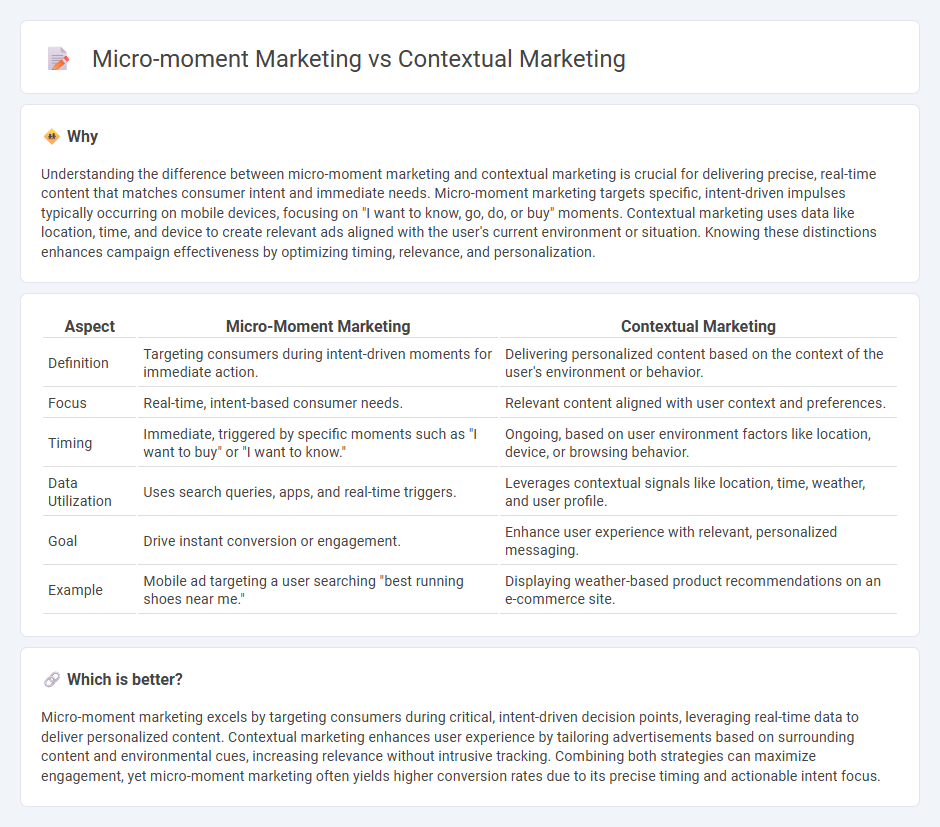
Micro-moment marketing targets consumers' immediate needs by delivering relevant content during critical decision-making moments on mobile devices. Contextual marketing leverages real-time data such as location, device, and browsing behavior to tailor personalized messages that resonate with the audience's current environment. Explore deeper insights to understand how these strategies can boost engagement and conversion rates effectively.
Why it is important
Understanding the difference between micro-moment marketing and contextual marketing is crucial for delivering precise, real-time content that matches consumer intent and immediate needs. Micro-moment marketing targets specific, intent-driven impulses typically occurring on mobile devices, focusing on "I want to know, go, do, or buy" moments. Contextual marketing uses data like location, time, and device to create relevant ads aligned with the user's current environment or situation. Knowing these distinctions enhances campaign effectiveness by optimizing timing, relevance, and personalization.
Comparison Table
| Aspect | Micro-Moment Marketing | Contextual Marketing |
|---|---|---|
| Definition | Targeting consumers during intent-driven moments for immediate action. | Delivering personalized content based on the context of the user's environment or behavior. |
| Focus | Real-time, intent-based consumer needs. | Relevant content aligned with user context and preferences. |
| Timing | Immediate, triggered by specific moments such as "I want to buy" or "I want to know." | Ongoing, based on user environment factors like location, device, or browsing behavior. |
| Data Utilization | Uses search queries, apps, and real-time triggers. | Leverages contextual signals like location, time, weather, and user profile. |
| Goal | Drive instant conversion or engagement. | Enhance user experience with relevant, personalized messaging. |
| Example | Mobile ad targeting a user searching "best running shoes near me." | Displaying weather-based product recommendations on an e-commerce site. |
Which is better?
Micro-moment marketing excels by targeting consumers during critical, intent-driven decision points, leveraging real-time data to deliver personalized content. Contextual marketing enhances user experience by tailoring advertisements based on surrounding content and environmental cues, increasing relevance without intrusive tracking. Combining both strategies can maximize engagement, yet micro-moment marketing often yields higher conversion rates due to its precise timing and actionable intent focus.
Connection
Micro-moment marketing and contextual marketing are connected through their focus on delivering relevant content exactly when consumers show intent, leveraging real-time data such as location, device, and behavior to personalize experiences. Both strategies prioritize understanding and anticipating user needs during specific moments of decision-making to enhance engagement and conversion rates. Integrating these approaches allows marketers to create timely, context-aware interactions that drive immediate actions and improve overall campaign effectiveness.
Key Terms
Contextual Marketing:
Contextual marketing delivers personalized content by analyzing real-time data such as user location, device type, and browsing behavior to create relevant advertisements tailored to the immediate environment of the consumer. It enhances user engagement by aligning marketing messages with the context in which consumers interact with digital platforms, resulting in higher conversion rates compared to traditional targeting methods. Discover how leveraging contextual marketing can optimize your campaigns and maximize ROI.
Personalization
Contextual marketing tailors content based on real-time user data such as location, device, and browsing behavior to deliver relevant messaging during a specific interaction. Micro-moment marketing targets critical moments when consumers instinctively turn to their devices to act on a need, emphasizing immediate and hyper-personalized experiences. Explore how leveraging both strategies can enhance personalization for higher engagement and conversion rates.
Real-time Data
Contextual marketing leverages real-time data to deliver personalized content based on a user's current environment and behavior, while micro-moment marketing targets critical decision-making instances with timely, relevant messages. Both strategies depend heavily on analyzing live user data such as location, device usage, and browsing activity to optimize engagement and conversion rates. Explore how integrating advanced analytics can enhance your real-time marketing effectiveness.
Source and External Links
Contextual Marketing: What It Is + How It Works with Examples - Contextual marketing is an advertising method that places ads in relevant environments based on user interests, needs, and circumstances, creating a more personalized and effective marketing experience through either general strategy or programmatic applications.
What is contextual marketing and how does it work? - It is an online marketing strategy serving targeted ads based on users' search terms or browsing behavior to increase relevance and conversion rates while minimizing user annoyance.
What is Contextual Marketing? Definition & Examples - Contextual marketing targets specific audiences with tailored content at the right time, demonstrated by brands like Johnson & Johnson and Amazon using contextual ads linked to user interests and real-world situations.
 dowidth.com
dowidth.com